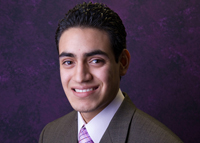|
|
Sources: Jesus Garcia, jegarcia@k-state.edu;
and Brett Wong, 785-532-4843, bwong@k-state.edu
Pronouncer: Jesus is Hay-seus
Photo available. Contact media@k-state.edu or 785-532-6415.
Video Available. Access at www.k-state.edu/media/audio/podcasts/devscholars.mov
Download information is available at www.k-state.edu/media/audio/podcastindex.html
News release prepared by: Kristin Hodges, 785-532-6415, khodges2@k-state.edu
Wednesday, Feb. 4, 2009
K-STATE STUDENT RESEARCHES STRESSORS FROM FIGHTER PILOTS' UP-DOWN MANEUVERS
MANHATTAN -- Aircraft fighter pilots might experience extreme maneuvers in the sky, but one Kansas State University student stays close to the ground when researching the pilots' nosedives.

Jesus Garcia, junior in public health nutrition, biology and premedicine, Merriam, is researching how the body's skin blood vessels respond to the physical and environmental stresses that pilots undergo.
Garcia is working with Brett Wong, assistant professor of kinesiology at K-State, to simulate the nose-down and nose-up maneuvers pilots experience. In Wong's Cardiovascular and Thermal Physiology Laboratory, the researchers tilt students on an automatic tilt table with their heads down for 30 seconds and then immediately tilt them head up.
The research is simulating the push-pull gravitational stress that pilots experience when they push on the control stick to do a nose-down maneuver and when they pull on the stick to do a nose-up maneuver, Wong said. He said a pilot's ability to withstand the G-force is much less when they do a nose-down followed by a nose-up maneuver compared to a nose-up maneuver alone.
Garcia said when pilots do a down maneuver quickly followed by an up maneuver, there is poor blood flow to the brain, which is why there have been cases in the past where pilots pass out and accidents happen.
"Since fighter pilots are wearing several layers of equipment, are in an enclosed cockpit, and, since many these pilots are currently in either Iraq or Afghanistan, both in relatively warm climates, it is important to understand how G-tolerance is potentially affected by heat stress in humans," Wong said.
Along with sweating, an increase in blood flow to the skin is the primary means by which humans regulate body temperature during heat stress, and an increase in skin blood flow could potentially cause a further decrease in fighter pilots' tolerance to G-forces.
Garcia has worked with Wong for the last two years through K-State's Developing Scholars Program, which pairs underrepresented students with faculty mentors for research projects. He worked in a lab in the College of Veterinary Medicine during his first year in the program.
"Jesus demonstrated great potential and scholarship as an undergraduate researcher," Wong said. "The physiology underlying his specific project is complex, and he did a great job integrating a lot of new and challenging information."
Garcia said the Developing Scholars Program has allowed him to network with people on the K-State campus. He said the program's director, Anita Cortez, has been like a second mom to him while at K-State.
"She's always pushing us and trying to guide us into the right path, and always giving us motivation," he said. "The Developing Scholars Program is basically like a big family. That's the way I see it."
Garcia started at K-State as a pre-veterinary medicine student, and later realized he was more interested in public health. His passion for the medical field began when he was young, when he already was spending time in laboratories.
Before Garcia moved to Merriam at age 15, he grew up in Toluca, Mexico, where his dad was a pharmacologist.
"He used to take me to the lab when I was little, and I would just observe," Garcia said. "It was interesting to see all these people wearing white coats and looking at samples."
Garcia would like to go to medical school to be a pediatrician, and he said he thinks his research will help him get accepted.
Garcia also is in K-State's McNair Scholars Program and a member of the Hispanic American Leadership Organization. He is the president of Sigma Lambda Beta fraternity and a K-State multicultural ambassador. A 2006 graduate of Shawnee Mission North High School, he is the son of Fernando and Lillian Garcia, Merriam.